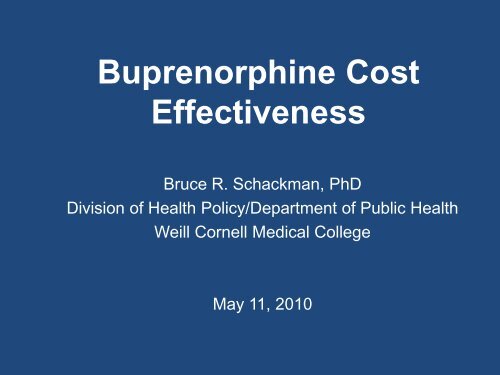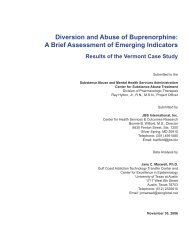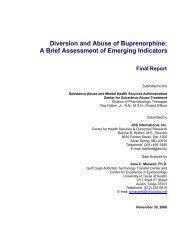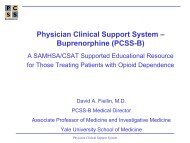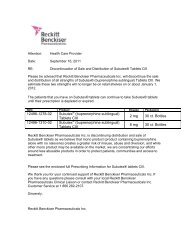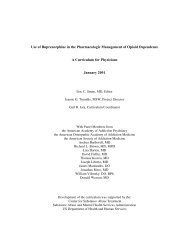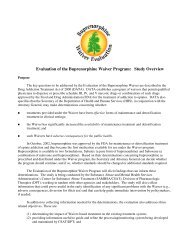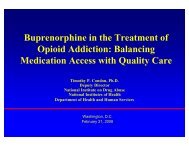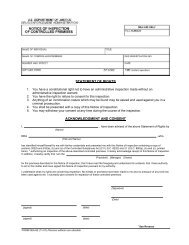Buprenorphine Cost Effectiveness
Buprenorphine Cost Effectiveness
Buprenorphine Cost Effectiveness
You also want an ePaper? Increase the reach of your titles
YUMPU automatically turns print PDFs into web optimized ePapers that Google loves.
<strong>Buprenorphine</strong> <strong>Cost</strong><br />
<strong>Effectiveness</strong><br />
Bruce R. Schackman, PhD<br />
Division of Health Policy/Department of Public Health<br />
Weill Cornell Medical College<br />
May 11, 2010
Funding<br />
• Robert Wood Johnson Foundation<br />
Substance Abuse Policy Research Program<br />
Grant # 63625<br />
• U.S. Department of Health and Human<br />
Services, HRSA HIV/AIDS Bureau’s Special<br />
Project of National Significance<br />
2
<strong>Buprenorphine</strong> <strong>Cost</strong><br />
• <strong>Cost</strong> has been considered a barrier to adoption<br />
– Drug cost is at least 7x higher than methadone, but<br />
methadone is very rarely used in the outpatient setting<br />
• Brand-name buprenorphine lost patent<br />
exclusivity in October 2009<br />
– Brand-name buprenorphine/naloxone (Suboxone) has<br />
no generic competitors<br />
– Brand-name buprenorphine (Subutex) has one<br />
generic competitor<br />
• <strong>Cost</strong> is estimated to be 80% of Subutex cost<br />
3
Questions Policy Makers May Ask<br />
• How much will it cost my budget next year?<br />
• Can I afford it?<br />
• Is it a good value from my perspective?<br />
– “Evidence-based” ?<br />
– “<strong>Cost</strong>-effective” ?<br />
4
<strong>Cost</strong>-effectiveness ≠ <strong>Cost</strong> saving
<strong>Cost</strong>-<strong>Effectiveness</strong> is About<br />
Value for Money<br />
• Very, very few health interventions save more<br />
money than they cost<br />
• <strong>Cost</strong>-effectiveness analysis is about<br />
comparative assessment of worth<br />
• Investments in health can be compared to<br />
evaluate competing claims on scarce<br />
resources<br />
6
Questions Policy Makers Should Ask<br />
• Is it a good long-term value from society’s<br />
perspective?<br />
– Use cost-effectiveness as a threshold<br />
– If no, stop; if yes, continue<br />
• What is the relevant comparator? (e.g.<br />
“standard of care” = no treatment)<br />
• Over what time period should the program be<br />
evaluated?<br />
• Which public and private payer budgets will be<br />
affected? Who wins? Who loses?<br />
7
<strong>Cost</strong>-effectiveness Ratio<br />
Additional Resources Used ($)<br />
Additional Health Benefits Gained (QALYs)<br />
8
<strong>Cost</strong>-effectiveness vs cost-benefit?<br />
• <strong>Cost</strong>-benefit analysis (CBA) allows consideration<br />
of benefits and costs outside the health care system<br />
– CBAs have shown methadone maintenance to be costsaving<br />
considering savings in crime costs, welfare<br />
payments, and health care costs and/or increases in<br />
earnings 1<br />
• Issues:<br />
– Lack of data requires extrapolation from studies of<br />
methadone treatment and heroin use; may not be relevant to<br />
prescription opioid dependent patients<br />
– CBA is not commonly accepted for evaluating medical<br />
treatments; cannot compare results to other pharmaceutical<br />
interventions<br />
1 Simoens et. al, Drug Alcohol Dep, 2006<br />
9
Published <strong>Cost</strong>-<strong>Effectiveness</strong> Studies (1)<br />
• UK National Health Service (NICE) study 1<br />
– Compared daily dispensing of buprenorphine and<br />
methadone<br />
– CE ratio of buprenorphine vs no treatment was<br />
£26,400/QALY ($13,400/QALY)<br />
– <strong>Buprenorphine</strong> was more costly and less effective<br />
than methadone<br />
• 3 Australian studies conducted alongside<br />
randomized trials 2<br />
– Time horizon 3-12 months<br />
– Similar costs and outcomes for buprenorphine and<br />
methadone<br />
1 Connock et al. Health Technology Assessment, 2006<br />
2 Doran et. al, Drug Alcohol Depend, 2003; Harris et al. Pharmacoeconomics, 2005; Gibson et al. Med J Aust, 2003 10
Published <strong>Cost</strong>-<strong>Effectiveness</strong> Studies (2)<br />
• <strong>Cost</strong>-effectiveness based on prevention of HIV<br />
transmission among US IDUs 1<br />
– Compared buprenorphine to methadone and<br />
buprenorphine to no treatment<br />
– In most scenarios buprenorphine had a cost-effectiveness<br />
ratio of
Current Study<br />
• To evaluate the cost-effectiveness of long-term officebased<br />
buprenorphine treatment compared to no treatment<br />
for clinically stable patients<br />
– Assume patients are unwilling or unable to engage in<br />
methadone maintenance treatment<br />
– Medical perspective taking into account patient benefits<br />
measured in QALYs<br />
• To evaluate the impact of uncertainty about model inputs<br />
on cost-effectiveness results<br />
– Price of buprenorphine<br />
– Duration of treatment<br />
– Quality of life on/off buprenorphine<br />
12
Enter<br />
In Treatment<br />
Off Drugs<br />
In Treatment<br />
On Drugs<br />
Model<br />
Off Treatment<br />
Off Drugs<br />
Off Treatment<br />
On Drugs<br />
Note: Separate models run for injection drug users (IDUs) and non-IDUs<br />
13
Data from Published Cohort Study<br />
• Patients had been followed in an RCT of buprenorphine<br />
management strategies and successfully completed 24 weeks on<br />
buprenorphine/naloxone (w/ at least 9 weeks abstinence) 1<br />
• We used follow-up study data on retention in treatment up to 24<br />
months after completion of the RCT 2<br />
• For those not retained in treatment, assumed 89% to be actively<br />
using drugs when out of treatment 3<br />
• Unit cost data from previous analysis of the same cohort 4<br />
• Average weekly cost for IDU and non-IDUs calculated based on<br />
patient-level resource utilization<br />
• For sensitivity analysis on drug cost, examined generic cost 80% of<br />
branded cost<br />
1 Fiellin et. al, N Engl J Med, 2006<br />
2 Fiellin et. al, Am J Addict., 2006<br />
3 Connock et al. Health Technology Assessment, 2006<br />
4 Jones et. al, Drug Alcohol Depend., 2009<br />
14
Cohort Retention In Treatment By Month<br />
Probability<br />
of Retention<br />
100%<br />
90%<br />
80%<br />
70%<br />
60%<br />
50%<br />
40%<br />
30%<br />
20%<br />
10%<br />
0%<br />
Retention Rate by Month<br />
0 1 2 3 4 5 6 7 8 9 10 11 12 13 14 15 16 17 18 19 20 21 22 23 24<br />
Months in Treatment<br />
15
Preliminary cost-effectiveness results to<br />
be presented at meeting
Limitations<br />
• Cohort treated at a single site<br />
• Drug use out of treatment was not observed,<br />
we assume 89% return to drug use based on<br />
available data<br />
• Ignores 6-month “start-up” costs and benefits<br />
• Ignores other costs and benefits<br />
• Other medical costs saved or incurred<br />
• Deaths avoided<br />
17
Conclusions<br />
• Office-based buprenorphine for clinically<br />
stable patients is cost-effective compared to<br />
no treatment using accepted thresholds for<br />
medical treatment in the US<br />
• Price reductions have a small effect on costeffectiveness<br />
findings<br />
– Not appropriate to refuse treatment coverage until<br />
generic buprenorphine/naloxone is available on<br />
the basis of cost-effectiveness<br />
• Lack of certainty about quality-of-life weights<br />
reduces robustness of findings<br />
– Further research about quality of life on and off<br />
buprenorphine is necessary<br />
18
• David Fiellin, MD<br />
• Jared Leff, MS<br />
Acknowledgments<br />
• Daniel Polsky, PhD<br />
• Brent Moore, PhD<br />
• Emlyn Jones, MD<br />
• Ashley Eggman, MS<br />
19


